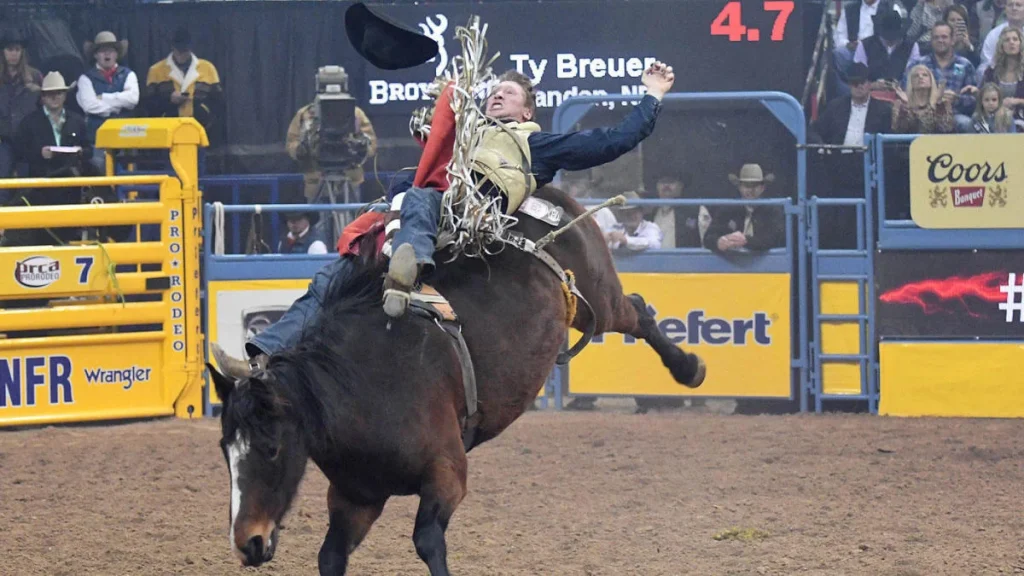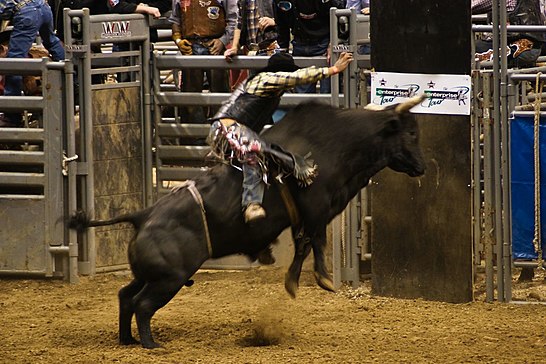The national final rodeo, the Professional Rodeo Cowboys Association (PRCA), is the premier championship rodeo event in the United States. The NFR showcases the talents of the top 15 PRCA medalists in each tournament as they compete for the world title.
The NFR is held every year on the first full week of December at the Thomas Mack Center on the campus of the University of Nevada, Las Vegas. (UNLV) and broadcast live on The Cowboy Channel. Cowboy Christmas, a cowboy gift show, is held in conjunction with the rodeo at the Las Vegas Convention Center.
Due to COVID-19, the rodeo has been temporarily moved to the Globe. Life Field in Arlington, Texas. NFR is scheduled to take place from 3 to 12 December 2020.
Because the rodeo uses “special dirt”, the dirt is stored on the UNLV campus for use in the next NFR.

Developments
NFR is the last rodeo event of the PRCA season. World Championship titles are awarded to individuals who earn the most money from their event during the year.
7 competitions and 10 championships are sanctioned by the PRCA: the steering rope is published separately and its finals are held separately at the Steer Roping National Finals. Barrel racing is legal by the Women’s Professional Rodeo Association (WPRA).
bronc riding – There are two divisions in rodeo: bareback riding, where the rider is only allowed to ride a bucking horse with a type of horse called “rigging”; and saddle “bronk” riding, where the rider uses a special western saddle without a horn (for safety) and hangs from a heavy lead rope called a “bronk” that is attached to the halter on the horse. 186>Tethering rope – also called calf rope, is based on the ranch where calves are tied with ropes for branding, treatment, or other purposes. This is the oldest event held during the rodeo. The cowboy ties the running calf to the neck with a lariat, his horse stops and mounts the rope again, while the cowboy dismounts, runs to the calf, throws it to the ground, and ties three of its legs together. (If the calf has fallen tied to the rope, the cowboy must lose time waiting for the calf to get back on its feet so the cowboy can do the job.) The horse’s job is to keep the calf on the rope. A well-trained horse on a calf rope will back away slowly while the cowboy ties up the calf to keep the lariat snug.
Barrel Racing is a competition for speed and agility.
In barrel racing, the horse and rider gallop around cloverleaf barrels, making quick turns without knocking over the barrels. In professional, collegiate, and high school rodeos, barrel racing is an exclusively women’s sport, although men and boys sometimes compete in local O-Mok-See events. Barrel racing is run in conjunction with other PRCA sanctioned events but is sanctioned by the Women’s Professional Rodeo Association (WPRA). The results are shown on this website.
Steer Wrestling – Also known as “Bulldogging”, this is a rodeo in which a rider jumps off his horse onto a Corriente steer and rips it off the ground by grabbing its horns. This is probably the most physically dangerous event in rodeo for a cowboy, who runs the risk of head-jumping off a running horse and missing or falling on top of the steer, sometimes with his horns. 182>Team Roping – Also referred to as ‘course and roll’, this is the only rodeo where men and women compete together. Two people catch and hold an adult bull. One horse and rider, “header”, lasso is the horns of a running bull, and the other horse and rider, “hiller”, is a lasso, two hind legs of a bull. After the animal has been caught, the riders look at each other and lightly pull the rudder between them so that both ropes are taut. This technique originated from the capture and containment methods for treatment used on the ranch.
Bull riding is an event in which cowboys ride adult bulls instead of horses.
While skills and equipment similar to those required for bareback riding are required, the event differs significantly from riding competitions due to the danger. Since bulls are unpredictable and may attack a fallen rider, rodeo clowns, now known as “bullfighters”, work during riding competitions to distract bulls and help prevent injury to competitors.
Steer Roping – on a rope. Instead of a calf, a cowboy must catch and tie a large steer (about 450 to 600 pounds). Unlike a tie rope, the cowboy must first tie the steer to his horns. The rudder horns are wrapped and then reinforced with reinforcement. Then the cowboy must throw the rope over the right thigh of the rudder. He then drives to the left, causing the steer to fall to the ground. Once the bull is on its side and the rope is taut, it can dismount. He will run towards the bull to tie any three legs together. As with the tie-down rope, the tie must be held for six seconds.

Riding is a rough standard activity for boys and girls, with children riding bulls, usually in a bull-like manner. Age varies by region, as there are no national rules for this competition, but generally contestants are at least eight years old and compete until around age 14. This is a training event for armor riding and bull riding.
All-Around – The all-around cowboy is actually an award, not an event. It is awarded to the winner with the largest prize pool in two or more competitions.
Barrel Racing is a timed speed and agility competition. In barrel racing, the horse and rider gallop around cloverleaf barrels, making quick turns without knocking over the barrels.
In professional, collegiate, and high school rodeos, barrel racing is an exclusively women’s sport, although men and boys sometimes compete in local O-Mok-See events. Barrel racing is run in conjunction with other PRCA sanctioned but WPRA sanctioned events. The results are shown on this website.
The All Around title is awarded at the end of the NFR to the highest paid cowboy who has competed regularly in more than one event during the year. In addition to the world championships, each event determines the average winner.
Since this event is extremely popular, all seats are sold out for all events. Many casinos host live events on their sportsbooks or throw special parties to accommodate all the fans in town who can’t get event tickets. Most major hotels and casinos book special entertainment in their country-themed showrooms, offering many of the regular shows with extended breaks.
